Introduction
Urbanisation is one of the most important demographic trends of our time. In 2008, the number of people living in urban centres worldwide has for the first time surpassed the number of people living in rural areas. It is estimated that by 2050, the percentage of urban population will reach nearly 70% (BIRCH et al. 2012).
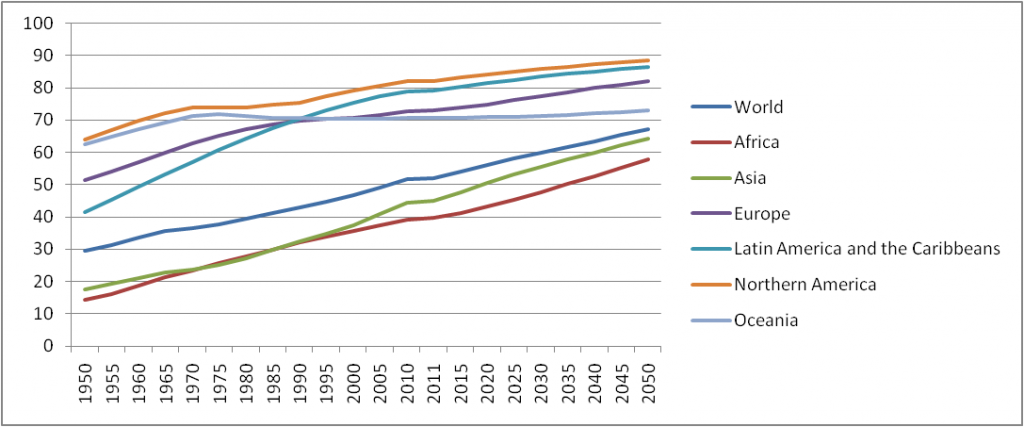
Urbanisation trends and estimates in major regions of the world (in % from 1950 to 2050). Source: UN-DESA (2010) and UN-DESA (2011)
Four main factors are responsible for urban growth: a) the natural demographic growth of urban populations, b) the absorption of rural settlements located at the edges of expanding cities, c) the transformation of rural towns into urban centres and d) migratory movements from rural areas to cities.
Urbanisation represents a challenge for water and sanitation management in developed as well as in developing countries. While cities in developed countries often struggle with high operation and maintenance costs and the decay of existing infrastructure, rapid urban growth in the developing world is seriously outstripping the capacity of most cities to provide adequate services for their citizens (COHEN 2006). In rapidly growing urban slums where there is no planning and few facilities, the number of people living without access to basic water and sanitation services is still increasing. This is of particular concern considering that the WASH sector represents the foundation on which broader goals of poverty reduction, environmental sustainability, social development, and gender equality must be built (BIRCH et al. 2012) (see also access to water and sanitation and water sanitation and development).
The Challenge of Water Supply and Sanitation in the Context of Urbanisation
Conventional urban water supply and sanitation management is generally characterised by an unsustainable use of water and nutrients. This represents important environmental, economic and social challenges, which are intensified by the process of urbanisation.
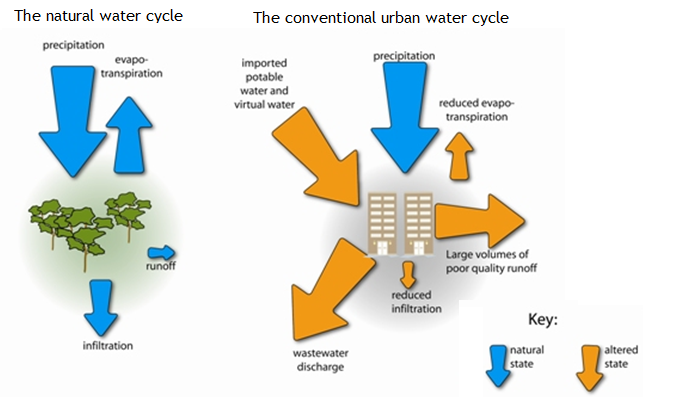
Major differences between the natural water cycle and the conventional urban water cycle. Source: HEALTHY WATERWAYS (2011)
- Disruption of the natural water cycle: The conventional urban water cycle is characterised by a linear infrastructure that transportsclean water into and wastewater out of urban neighbourhoods. Due to a high percentage of sealed soil and thus impervious surfaces, evapotranspiration and groundwater recharge are reduced and low quality surface runoff is increased – utilities are often left to deal with extremely large volumes of water, especially during wet weather (CORCORAN et al. 2010). Climate change will further intensify these challenges in many regions as it will lead to more erratic patterns of droughts and storms.
- Pollution of water sources: Urban settlements are the main source of point source pollution (UNESCO et al. 2004). It is estimated that more than 90% of sewage in the developing world is discharged directly into rivers, lakes, and coastal waters without treatment of any kind (LUETHI et al. 2009). In low- and middle-income countries, leaking on-site sanitation facilities together with the absence of sewerage pipes that dispose the wastewater, result in large volumes of local wastewater soaking into the soil, and eventually seeping into aquifers and polluting groundwater (GROENWALL et al. 2010).
- Depletion of groundwater sources: In urban settings, the use of shallow groundwater sources is an especially common feature of many low-income communities in low- and middle-income countries. More than half of the world’s megacities depend on groundwater (see also sources of groundwater).
- Broken nutrient cycles and impoverished soils: The “end-of-pipe” paradigm discourages recovery and reuse so that nutrients are lost to water bodies. This waste of valuable resources can lead to eutrophication and cause algal blooms and a depletion of oxygen in receiving water bodies (HOWE et al. 2011, see also sanitation systems). In Africa, 85% of arable land is losing an average of 30kg of nutrients per hectare per year (LUETHI et al. 2009).
- Waste of resources: Water treated to potable water is used for non-potable purposes such as toilet flushing, garden use and industry. When water is heavily invalid link or charged based on a fixed rate, users have little financial incentive to use it sparingly (HOWE et al. 2011).
- High water demand: The concentration of a great quantity of population and activities on a small area involve the need of a great amount of good quality water (CHOCAT 2002). Urban areas usually have a higher per capita consumption of water compared to rural areas. Water demand is additionally increased as urban population grows and per capita water consumption in many cities is on the rise (see also water use).
- Cost-intensive infrastructure for water supply and wastewater collection: The increase of urban population asks for a continuous expansion of water networks and wastewater networks (see also wastewater collection and treatment). Centralised networks are very cost-intensive in terms of construction, operation and maintenance. If the networks are not sufficiently maintained, leakages lead to a loss of valuable resources, unreliable or irregular water supply and low revenue collection for the utilities (see also leakage control). Many large cities suffer from chronic water shortages due to over-exploitation of raw water resources, and to losses of water, which sometimes reach up to 60% of the volume of water supplied (UNESCO et al. 2004).
Water Supply and Sanitation in Slum Settlements: A Particular Challenge for Developing Countries
Apart from the general challenges of water supply and sanitation in the context of urbanisation, which have been described above, developing countries are often confronted with an additional challenge: the rapid growth of slum settlements (also referred to as “peri-urban areas” as they are often located at the peripheries of the cities, e.g. favelas in Brazil or townships in South Africa). Data suggests that in a large number of the world’s poorest countries, the proportion of urban poor is increasing faster than the overall rate of urban population growth. An estimated 72 % of the urban population of Africa now live in slums. The proportion is 43 percent for Asia and the Pacific, 32 percent for Latin America, and 30 percent for the Middle East and Northern Africa (COHEN 2006).
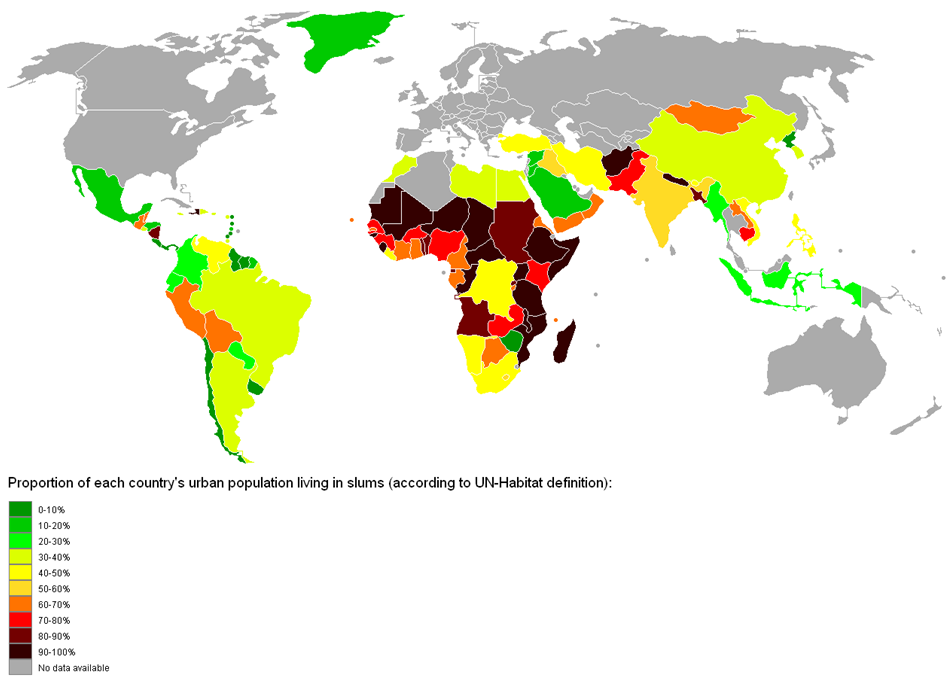
The proportion of each country’s urban population living in slums. Source: SPAGNOLI (n.y.)
Characteristics of Slum Settlements
- The unplanned (informal) character of the settlements: Informal settlements (also called squatter settlements or shanty towns) are (sometimes illegal) settlements, which have emerged in the course of rapid urbanisation, unguided by urban planning. Irregular layout and spontaneous construction make the subsequent expansion of networks into densely populated areas extremely difficult.
- High population density: As population density is commonly extremely high, there is not much space left for the construction of water, sanitation and treatment facilities or network expansions.
- Low tenure security: Because informal settlements lack land tenure, providing water and sanitation services through investments in large infrastructure is extremely difficult (CORCORAN et al. 2010). In some cases, utilities are not allowed to expand their services to illegal settlements.
- Low-income areas: Slum settlements are characterised by high poverty rates. People are therefore often not able to pay for network expansion and improved service delivery.
- The relative distance to existing networks, particularly of slums located at the peripheries of the cities, makes network expansion very costly.
Water Supply and Sanitation in Slum Settlements
Households with water (left) and sewerage (right) connection in sub-Saharan African Cities. Source: WUP & WSP (2003)
Although efforts to achieve universal water access have been underway for decades (see also the right to water and sanitation and water sanitation and development), the number of people living without access to basic water and sanitation services is still increasing. One main reason for this is the rapid expansion of urban slums where the characteristics described above make the provision of basic infrastructure extremely difficult. Urban slums therefore generally lack improved water supply and sanitation facilities and other infrastructure such as roads, electricity and solid wastecollection.
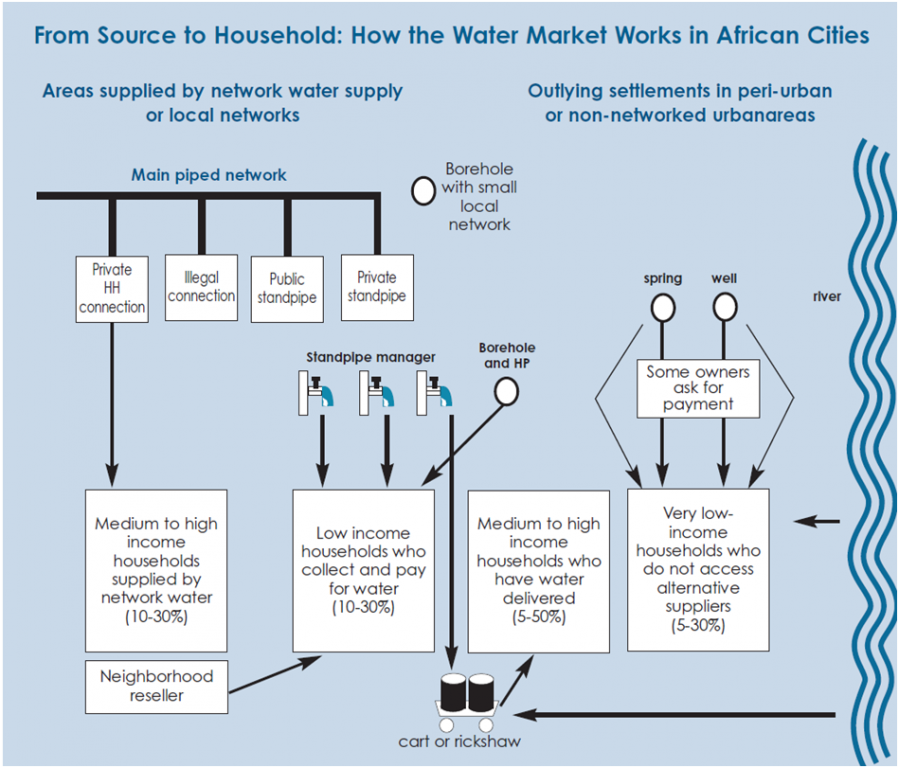
Typical Water Market Situation in African Cities. Source: WUP & WSP (2003)
In order to cover their needs with respect to water supply, the peri-urban poor often depend on a variety and combination of means such as hand dug wells, boreholes, water vendors, rainwater harvesting, privately operated wells and human-powered distribution or motorised distribution, gifts from neighbours, informal operators or clandestine connections. The sources that are used vary according to their availability and accessibility and to the intended use.
Pit latrines are commonsanitation facilities in urban slums. However, in many cases even such basic means are lacking and people are forced to practice open defecation or dispose of their excreta in plastic bags which they throw on the roofs or at the street (so-called “flying toilets”).
Consequences of the lack of water supply and sanitation services
- Pollution of water sources: Due to a lack of space, pit latrines are often constructed close to groundwater sources such as wells, hand pumps or springs. During heavy rains, the latrines tend to get flooded, resulting in water seeping through the soil, contaminating the groundwater. Additionally, asthe impervious and unvegetated ground of slum areas has little or no retention during heavy rains, human and animal wastes are flushed into the river systems polluting urban water supplies, rivers and productive coastal waters (MAFUTA et al. 2011).
- Health: Approximately 80% of all diseases and 25% of all deaths in developing countries are caused by polluted water and insufficient water supply, sanitation and hygiene (LUETHI et al. 2009). This situation is particularly accentuated in urban slums where access rates to WASH services are typically very low. Among the most common diseases are diarrhoea, cholera, malaria, dysentery, schistosomiasis, dengue fever, typhoid fever, gastroenteritis, hepatitis A and cancer. Diarrhoeal diseases pose a serious risk of malnutrition.
- Poverty [Adapted from NORSTROEM 2007]: Adults who are ill themselves or who need to take care of their children are less productive. Additionally, the health costs induced by the lack of adequate water, sanitation and hygiene practices can consume a large part of the poor household’s income. The time spent to fetch water cannot be invested into income-generating activities (see also water sanitation and development).
- Education and Gender [Adapted from BIRCH et al. 2012]: While the process of urbanisation critically reduces the average time spent by women collecting water when compared to their rural counterparts, the increased risk of contracting water-borne diseases as the primary handlers of contaminated water, the serious challenge to reproductive health presented by a lack of clean water and hygiene services, and the added responsibility of providing care to children and other family members suffering from illness continue to effectively exclude many women and girls from educational opportunities.
- Dignity and Security: Due to the lack of adequate sanitation facilities, many people living in urban slums are forced to defecate in the open. In order to preserve their dignity, they often try to defecate in the open under cover of darkness. This poses an important security risk, particularly for women and girls. This risk is also given if water needs to be fetched during the night.
- Economic costs: Illnesses, high rates of mortality and reduced productivity induce large economic costs. It is estimated that Sub-Saharan Africa loses around 5 per cent of Gross Domestic Product (GDP) due to ill-health because of poor water and sanitation – more than the total value of aid these countries receive (TEARFUND 2008). Studies have shown that investments in sustainable sanitation in developing regions brings a return in the range of US$5 to US$46 (depending on the intervention) for every US$1 invested (LUETHI et al. 2009).
The Way Forward: Urban SSWM (Sustainable Sanitation and Water Management)
Although urban areas present major challenges for adequate water and sanitation management, “they also present a potential efficiency of scale in basic service provision never possible in the rural context. Urban systems also present the best opportunity for a transition to integrated service management, leveraginginvestments in energy, transportation, water, and sanitation in order to create more innovative and environmentally sustainable human development and natural resource management” (BIRCH et al. 2012). In order to achieve urban sustainable sanitation and water management, the following aspects should be considered (see also case studies on Urban SSWM).
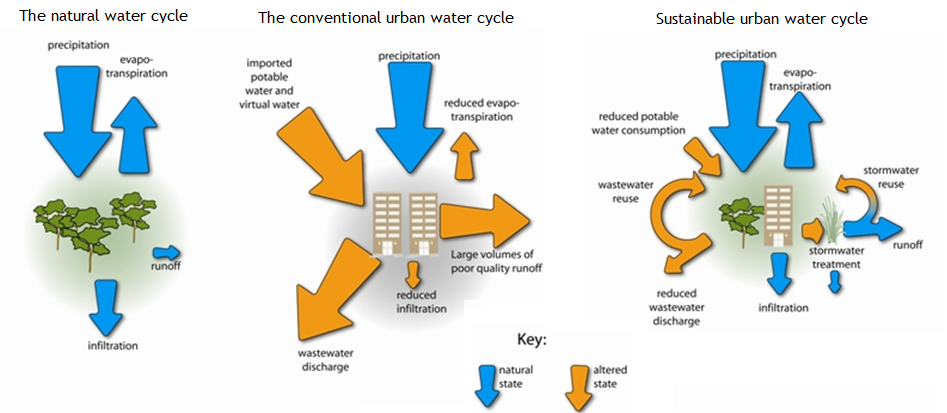
The natural water cycle, the conventional urban water cycle and the sustainable urban water cycle. Source: HEALTHY WATERWAYS (2011)
- Integrated approach: The conventional urban water cycle is fragmented into different sectors (water purification and water distribution, wastewater and stormwater). This may lead to missed opportunities and unexpected impacts. A governance andinstitutional change is therefore needed, which looks at water supply and sanitation systems in a holistic way. An integrated approach (including the different aspects of urban water management (see also water safety plans or city sanitation plans) and also other affected urban management sectors such as health, housing, energy or waste management) to urban water management makes it easier to identify and exploit positive links while minimising the negative implications throughout the system (HOWE et al. 2011).
- invalid link: Centralised systems of water and sanitation services as they exist in most cities of the developed world are proving not to be effective and efficient. Furthermore, they are very expensive. It does therefore not seem logical to use these systems in developing countries (CHOCAT 2002). Decentralised water supply and wastewater treatment systems offer increased opportunities for local stakeholder participation in planning and decision-making (see also the role of local governments in urban sustainable sanitation and water management), and for reutilisation of the resource at the local level (PARKINSON and TAYLER 2003) and should therefore be encouraged.
- Particularly in developing countries, public service providers are often unable to keep up with urban population growth as they face a double challenge of maintaining the existing and often deteriorated networks and of extending the services to the rapidly growing settlements at the peripheries of the cities. Through the engagement of the private sector (see e.g. invalid link or invalid link), service delivery can be improved as public utilities are relieved and additional revenue opportunities are created.
- invalid link resulting from sustainable sanitation and water management can include small-scale service provision for construction of appropriate system components, collection, transport, storage and processing/recovery of products from sanitation systems (e.g. biogas, fertiliser, soil conditioner or irrigation water), resources management (dealing with resources that are scarce in the local context and evaluating how a sanitation system can reduce resource pressure), surveys, analyses, and impact evaluation (e.g. market surveys, institutional analysis, impact evaluation of previous sanitation strategies, and sustainability assessments) (LUETHI et al. 2009) (see also Sanitation as a Business).
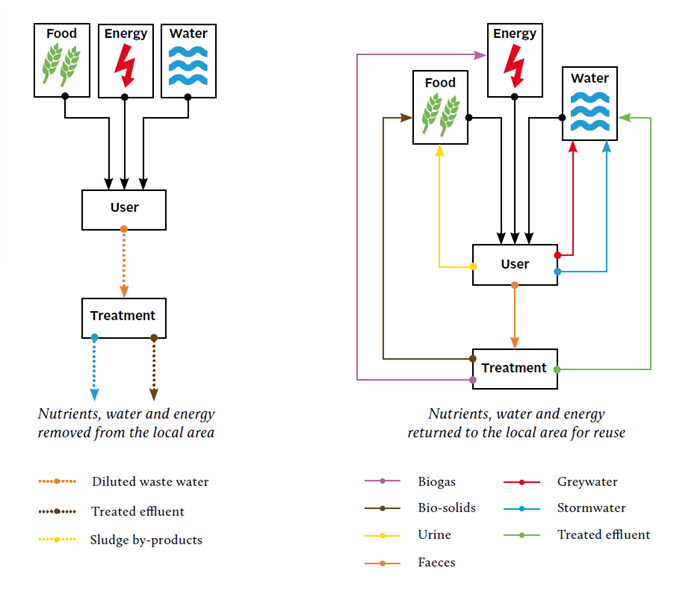
Linear versus cyclical wastewater management. Source: HOWE et al. (2011)
- Reuse opportunities: In the conventional urban water cycle, reuse opportunities remain largely unused, leading to a waste of valuable resources. Sustainable urban water and sanitation management takes advantage of the reuse options including the reuse of energy from wastewater through biogas, the reuse of wastewater and greywater for irrigation as well as the reuse of nutrients from human urine and excreta to recover nutrients and limited resources like phosphorus for agriculture.
- Financial sustainability: If water supply and sanitation solutions are to be sustainable, they need to remain operative over time. This requires sufficiently high investments in the water sector and sound financial planning.
- Stakeholder engagement (see also participatory decision making): Urban areas provide an ideal institutional structure for community engagement. Increased stakeholder engagement leads to better identification of challenges, demand-driven solutions and better commitment and ownership and thus to a more significant impact (see e.g. community-led urban environmental sanitation).
The Urban Water Transition
This paper addresses issues of water, sanitation and gender in the context of urbanisation.
BIRCH, E.L. ; MELEIS, A. ; WACHTER, S. (2012): The Urban Water Transition. Why We Must Address the New Reality of Urbanization, Women, Water, and Sanitation in Sustainable Development. In: sWH20: The Journal of Gender and Water : Volume 1 , 6-7. URL [Accessed: 24.09.2013]Sustainable Management of Water in Cities
This paper explores four scenarios extrapolating different present trends, showing that, without a clear and strong political and social involvement, the sustainability of water management in most of the cities is at least questionable. Nevertheless, holistic approaches, based on a sustainable urban management could offer a way out.
CHOCAT, B. (2002): Sustainable Management of Water in Cities. Valencia: Universidad Internacional Menendez Pelayo URL [Accessed: 12.09.2013]Urbanization in Developing Countries
This paper describes current trends and future projections of urbanisation in developing countries and discusses the challenges of rapid urbanisation for sustainability.
COHEN, B. (2006): Urbanization in Developing Countries. Current Trends, Future Projections, and Key Challenges for Sustainability. In: Technology in Society: Volume 28 , 63-80. URL [Accessed: 12.09.2013]Sick Water? The central role of wastewater management in sustainable development
This book not only identifies the threats to human and ecological health that water pollution has and highlights the consequences of inaction, but also presents opportunities, where appropriate policy and management responses over the short and longer term can trigger employment, support livelihoods, boost public and ecosystem health and contribute to more intelligent water management.
CORCORAN, E. ; NELLEMANN, C. ; BAKER, E. ; BOS, R. ; OSBORN, D. ; SAVELLI, H. (2010): Sick Water? The central role of wastewater management in sustainable development. A Rapid Response Assessment. United Nations Environment Programme (UNEP), UN-HABITAT, GRID-Arendal URL [Accessed: 05.05.2010] PDFGroundwater, self-supply and poor urban dwellers. A review with case studies of Bangalore and Lusaka
This review explores the extent to which urban dwellers in Bangalore and Lusaka directly and indirectly depend on groundwater. It elaborates on the difficulties they face as a result, and emphasises the need for better integration of groundwater in the planning and management of urban water resources.
GROENWALL, J. MULENGA, M. MCGRANAHAN, G. (2010): Groundwater, self-supply and poor urban dwellers. A review with case studies of Bangalore and Lusaka. (= Human Settlements Working Paper , 24 ). London: International Institute for Environment and Development (IIED) URL [Accessed: 15.03.2012] PDFWhat is Water Sensitive Urban Design?
Sustainable Water Management in the City of the Future. Findings from the SWITCH Project 2006-2011
Consolidating the findings from the ‘SWITCH – Managing Water in the City of the Future’ project (2006-2011), this book describes the research and knowledge sharing activities and outcomes from the 11 participating cities throughout the world that worked to facilitate a paradigm shift in urban water management through a more integrated approach.
HOWE, C. A. ; VAIRAVAMOORTHY, K. ; STEEN, P. N. van der (2011): Sustainable Water Management in the City of the Future. Findings from the SWITCH Project 2006-2011. Delft: UNESCO-IHE URL [Accessed: 06.02.2013]Rethinking Sustainable Sanitation for the Urban Environment
This paper gives an initial overview of the current state of urban sanitation with a North-South perspective, followed by a discussion of the new role of sustainable sanitation systems in future eco-cities. Planning innovations for urban sanitation, initial lessons learned and current challenges faced are addressed. Context specific challenges and opportunities are illustrated in a variety of urban settings, from non-tenured low-income settlements (slums) to middle- and high-income inner-city areas, to stimulate action on the ground.
LUETHI, C. MCCONVILLE, J. NORSTROEM, A. PANESAR, P. INGLE, R. SAYWELL, D. SCHUETZE, T. (2009): Rethinking Sustainable Sanitation for the Urban Environment. (= The 4th International Conference of the International Forum on Urbanism (IFoU) ). Amsterdam/Delft: International Forum on Urbanism (IFoU) URL [Accessed: 12.09.2013]Green Hills, Blue Cities: An Ecosystems Approach to Water Resources Management for African Cities
The case studies provided in this report emphasize the pivotal role of ecosystems in sustainable urban water supply and sanitation.
MAFUTA, C. ; FORMO, R.K. ; NELLEMANN, C. ; LI, F. (2011): Green Hills, Blue Cities: An Ecosystems Approach to Water Resources Management for African Cities. A Rapid Response Assessment. Arendal: United Nations Environment Programme (UNEP), United Nations Human Settlements Programme (UN-HABITAT), GRID-Arendal URL [Accessed: 17.09.2013]Planning for Drinking Water and Sanitation in Peri-Urban Areas
This report addresses the challenges of water supply and sanitation in the context of peri-urban areas and presents the Strategic Choice Approach as a potential framework for sustainable water and sanitation planning.
NORSTROEM, A. (2007): Planning for Drinking Water and Sanitation in Peri-Urban Areas. A Proposed Framework for Strategic Choices for Sustainable Living. (= Swedish Water House Report , 21 ). Stockholm: Swedish Water House (SWH) URL [Accessed: 16.09.2013]Decentralized Wastewater Management in Peri-Urban Areas in Low-Income Countries
Using examples of functioning systems, the paper discusses the operational sustainability of decentralized technologies for wastewater management in peri-urban areas and their associated management requirements.
PARKINSON, J. ; TAYLER, K. (2003): Decentralized Wastewater Management in Peri-Urban Areas in Low-Income Countries. In: Environment and Urbanization: Volume 15 , 75-90. URL [Accessed: 12.09.2013]Statistics on Poverty, Urbanization and Slums
Water and Sanitation: The Economic Case for Global Action
World Population Prospects
World Urbanization Prospects
Water, Sanitation and Sustainable Development
This paper describes the challenge of urbanisation in developing countries and proposes solutions for a more sustainable urban water management.
UNESCO ; VEOLIA WATER ; PS-EAU (2004): Water, Sanitation and Sustainable Development. The Challenge of Cities in Developing Countries. Paris: The United Nations Educational, Scientific and Cultural Organization (UNESCO), Veolia Water and Progamme Solidarité-Eau (pS-Eau) URL [Accessed: 13.09.2013]Sustainable Urban Water Management in Cape Town, South Africa
This paper describes the development of the “Sustainability Index for Integrated Urban Water Management” (SIUWM) for specific application to southern African cities. It reviews the results from initial testing of the index on Cape Town and discusses its usefulness in terms of sustainability assessment. The authors conclude that the SIUWM is able to highlight several critical areas of “unsustainability” in the city.
CARDEN, K. WINTER, K. ARMITAGE, N. (2009): Sustainable Urban Water Management in Cape Town, South Africa. Is it a Pipe Dream?. (= WEDC International Conference on Water, Sanitation and Hygiene, Addis Ababa, Ethiopia , 34 ). Leicestershire: Water, Engineering and Development Centre (WEDC) URL [Accessed: 11.09.2013]Urbanization in Developing Countries
This paper describes current trends and future projections of urbanisation in developing countries and discusses the challenges of rapid urbanisation for sustainability.
COHEN, B. (2006): Urbanization in Developing Countries. Current Trends, Future Projections, and Key Challenges for Sustainability. In: Technology in Society: Volume 28 , 63-80. URL [Accessed: 12.09.2013]Sick Water? The central role of wastewater management in sustainable development
This book not only identifies the threats to human and ecological health that water pollution has and highlights the consequences of inaction, but also presents opportunities, where appropriate policy and management responses over the short and longer term can trigger employment, support livelihoods, boost public and ecosystem health and contribute to more intelligent water management.
CORCORAN, E. ; NELLEMANN, C. ; BAKER, E. ; BOS, R. ; OSBORN, D. ; SAVELLI, H. (2010): Sick Water? The central role of wastewater management in sustainable development. A Rapid Response Assessment. United Nations Environment Programme (UNEP), UN-HABITAT, GRID-Arendal URL [Accessed: 05.05.2010] PDFSustainable Water Management in the City of the Future. Findings from the SWITCH Project 2006-2011
Consolidating the findings from the ‘SWITCH – Managing Water in the City of the Future’ project (2006-2011), this book describes the research and knowledge sharing activities and outcomes from the 11 participating cities throughout the world that worked to facilitate a paradigm shift in urban water management through a more integrated approach.
HOWE, C. A. ; VAIRAVAMOORTHY, K. ; STEEN, P. N. van der (2011): Sustainable Water Management in the City of the Future. Findings from the SWITCH Project 2006-2011. Delft: UNESCO-IHE URL [Accessed: 06.02.2013]Humanitarian Crisis Drivers of the Future
This paper is about the future of water and sanitation stress (Wat/San) in urban slums and how such stress is likely to exacerbate other humanitarian crises over time.
HUDSON-EDWARDS, K. RAFORD, N. (2009): Humanitarian Crisis Drivers of the Future. Urban Catastrophes: The Wat/San Dimension. London: Humanitarian Futures Programme, King’s College London URL [Accessed: 12.09.2013]Rethinking Sustainable Sanitation for the Urban Environment
This paper gives an initial overview of the current state of urban sanitation with a North-South perspective, followed by a discussion of the new role of sustainable sanitation systems in future eco-cities. Planning innovations for urban sanitation, initial lessons learned and current challenges faced are addressed. Context specific challenges and opportunities are illustrated in a variety of urban settings, from non-tenured low-income settlements (slums) to middle- and high-income inner-city areas, to stimulate action on the ground.
LUETHI, C. MCCONVILLE, J. NORSTROEM, A. PANESAR, P. INGLE, R. SAYWELL, D. SCHUETZE, T. (2009): Rethinking Sustainable Sanitation for the Urban Environment. (= The 4th International Conference of the International Forum on Urbanism (IFoU) ). Amsterdam/Delft: International Forum on Urbanism (IFoU) URL [Accessed: 12.09.2013]Planning for Drinking Water and Sanitation in Peri-Urban Areas
This report addresses the challenges of water supply and sanitation in the context of peri-urban areas and presents the Strategic Choice Approach as a potential framework for sustainable water and sanitation planning.
NORSTROEM, A. (2007): Planning for Drinking Water and Sanitation in Peri-Urban Areas. A Proposed Framework for Strategic Choices for Sustainable Living. (= Swedish Water House Report , 21 ). Stockholm: Swedish Water House (SWH) URL [Accessed: 16.09.2013]Decentralized Wastewater Management in Peri-Urban Areas in Low-Income Countries
Using examples of functioning systems, the paper discusses the operational sustainability of decentralized technologies for wastewater management in peri-urban areas and their associated management requirements.
PARKINSON, J. ; TAYLER, K. (2003): Decentralized Wastewater Management in Peri-Urban Areas in Low-Income Countries. In: Environment and Urbanization: Volume 15 , 75-90. URL [Accessed: 12.09.2013]Water, Sanitation and Sustainable Development
This paper describes the challenge of urbanisation in developing countries and proposes solutions for a more sustainable urban water management.
UNESCO ; VEOLIA WATER ; PS-EAU (2004): Water, Sanitation and Sustainable Development. The Challenge of Cities in Developing Countries. Paris: The United Nations Educational, Scientific and Cultural Organization (UNESCO), Veolia Water and Progamme Solidarité-Eau (pS-Eau) URL [Accessed: 13.09.2013]Better Water and Sanitation for the Urban Poor
This document is part of an initiative by the Water Utility Partnership (WUP) to document those policies, initiatives and activities that are considered to represent 'good practice' in the delivery of water and sanitation services to the urban poor by water utilities in Africa. These practices show sustainable and innovative ways of getting services to low-income communities. The document was developed from case studies undertaken in nine countries in sub-Saharan Africa over a two-year period.
WUP ; WSP (2003): Better Water and Sanitation for the Urban Poor. Good Practice from Sub-Saharan Africa. Kenya: Water Utility Partnership (WUP) and The World Bank Water and Sanitation Program (WSP) URL [Accessed: 13.09.2013]Building Towards a Future in Which Urban Sanitation Leaves No One Behind
This Brief highlights key findings from the papers in the October 2015 issue of Environment and Urbanization. And it makes some suggestions in light of the UN Summit in September 2015 that agreed on the Sustainable Development Goals (SDGs), which pledge to “leave no one behind”. Two goals are particularly relevant: Goal 6.2 with its general commitment to provide sanitation and Goal 11.1 with its commitment to upgrade informal settlements (slums(2)) with basic services
MITLIN, D. (2015): Building Towards a Future in Which Urban Sanitation Leaves No One Behind. (= Environment and Urbanization Briefs , 32 ). URL [Accessed: 11.05.2016]Governance for Water and Sanitation Services in Low-Income Settlements
This paper considers how sparsely populated, low-income and largely unserved urban settlements might obtain full coverage of formal water and sanitation networks under a private concession contract, drawing on the case study of Moreno municipality in Buenos Aires Metropolitan Area. The paper describes an initiative that seeks to address deficiencies in water and sanitation provision through partnership-based management, a participatory process whereby different types of actors collaborate with each other, bringing their own particular strengths.
HARDOY, A. ; HARDOY, J. ; PANDIELLA, G. ; URQUIZA, G. (2005): Governance for Water and Sanitation Services in Low-Income Settlements. Experiences with Partnership-Based Management in Moreno, Buenos Aires. In: Environment and Urbanization: Volume 17 , 183-200. URL [Accessed: 17.09.2013]Otji Toilets for Peri-urban Informal Households - Omaruru, Namibia
This case study is about pilot scale urine diversion dehydration toilets for peri-urban informal households in Omaruru, Namibia. The project was designed to show the advantages of dry sanitation systems in arid regions such as Namibia. It further aims at involving the local authorities in such a way that they can implement sanitation facilities in the future based on the findings of the pilot study.
KLEEMANN, F. BERDAU, S. (2011): Otji Toilets for Peri-urban Informal Households - Omaruru, Namibia. Case Study of Sustainable Sanitation Projects. Eschborn: Sustainable Sanitation Alliance (SuSanA) URL [Accessed: 11.10.2012]Green Hills, Blue Cities: An Ecosystems Approach to Water Resources Management for African Cities
The case studies provided in this report emphasize the pivotal role of ecosystems in sustainable urban water supply and sanitation.
MAFUTA, C. ; FORMO, R.K. ; NELLEMANN, C. ; LI, F. (2011): Green Hills, Blue Cities: An Ecosystems Approach to Water Resources Management for African Cities. A Rapid Response Assessment. Arendal: United Nations Environment Programme (UNEP), United Nations Human Settlements Programme (UN-HABITAT), GRID-Arendal URL [Accessed: 17.09.2013]Urban Urine Diversion and Greywater Treatment System Linz, Austria
This case study discusses a medium-scale pilot project in a new urban area in Linz, Austria. General objectives were the creation of a sustainable settlement in a new city district (high demand for residential buildings) and the establishment of ecological buildings and low energy construction concepts. Among specific objectives was the implementation of innovative solutions for water supply and wastewater treatment with a reduction of the infrastructure costs for municipal wastewater treatment. Also, the aim was to establish a holistic sanitation approach enabling the use of nutrients contained in excreta or wastewater in agriculture and to research treatment of micropollutants in urine.
OLDENBURG, M. WERNER, C. SCHLICK, J. KLINGEL, F. (2009): Urban Urine Diversion and Greywater Treatment System Linz, Austria. (= SuSanA - Case Studies ). Eschborn: Sustainable Sanitation Alliance (SuSanA) URL [Accessed: 24.09.2013]Ecological Settlement in Allermoehe Hamburg, Germany
This case study is about a full-scale residential settlement project in an urban area in Hamburg, Germany. The settlement was built between 1982 and 1994 and consists of 36 single-family houses with approx. 140 inhabitants. The project aims at having an ecological closed-loop process via on-site wastewater treatment and therefore independence from a sewage system. Rainwater harvesting, composting toilets and constructed wetlands were the technologies applied in the project. Thereby a high resource and energy efficiency can be achieved.
RAUSCHNING, G. BERGER, W. EBELING, B. SCHOEPE, A. (2009): Ecological Settlement in Allermoehe Hamburg, Germany. Eschborn: Sustainable Sanitation Alliance (SuSanA) URL [Accessed: 24.09.2013]Community-Driven Development for Water and Sanitation in Urban Areas
This booklet focuses on the role of these local, community-driven schemes in directly addressing the needs of the unserved or ill-served in urban areas.
SATTERTWAITHE, D. MCGRANAHAN, G. MITLIN, D. (2005): Community-Driven Development for Water and Sanitation in Urban Areas. Its Contribution to Meeting the Millennium Development Goal Targets. (= Input to the 13th Session of the Commission on Sustainable Development, New York ). Geneva: Water Supply and Sanitation Collaborative Council (WSSCC) URL [Accessed: 17.09.2013]Ecological Sanitation in Peri-Urban Area of El Alto City, Bolivia
This case study describes the project of UDDTs construction in El Alto, Bolivia. The project was implemented in a peri-urban area with an estimated population of roughly 27,000, composed mainly of Aymara indigenous people. The technology applied is a UDDT toilet with container, treatment of grey water at the household level, and collective management of the urine and faeces. The EcoSan approach was chosen due to its basic principle of zero or minimal use of water, an important adaptation measure in the face of rising temperatures and other climate change impact, while closing loops of water and nutrients.
SUNTURA, C. SANDOVAL, B. (2012): Ecological Sanitation in Peri-Urban Area of El Alto City, Bolivia. Case Study of Sustainable Sanitation Projects. Eschborn/La Paz/Stockholm: Sustainable Sanitation Alliance (SuSanA), Fundación Sumaj Huasi, Stockholm Environment Institute (SEI) URL [Accessed: 17.09.2013]The Growing Urban Crisis in Africa
Rapid urbanisation in developing countries is often coupled with high growth rates of low-income urban settlements. These areas often lack adequate water supply and sanitation services – a central key to social and economic development. This brochure uses the example of Kenya to illustrate why it is so important to integrate the water, urbanisation and demographics sector.
WERCHOTA, R. (2013): The Growing Urban Crisis in Africa. Water Supply, Sanitation and Demographic Challenges – the Kenyan Case. Eschborn: Deutsche Gesellschaft fuer Internationale Zusammenarbeit (GIZ) GmbH URL [Accessed: 26.08.2013]Urban Decentralised Wastewater Management Badlapur, Maharashtra, India - Draft
This case study is about a large-scale decentralised wastewater management and reuse project in Badlapur town, India, which serves 540 households. Treatment of domestic wastewater will happen in a decentralized treatment systems comprising a (biogas) settler, an anaerobic baffled reactor and an anaerobic upflow filter. The treated water shall be reused for irrigation purpose at the site. Biogas produced in the process of anaerobic wastewater treatment will be collected and shall be converted into electricity via a (bio) gas generator; the electricity can be stored in an accumulator (battery) and be used on-site to bridge power cuts.
ZIMMERMANN, N. WAFLER, M. (2009): Urban Decentralised Wastewater Management Badlapur, Maharashtra, India - Draft. Case Study of Sustainable Sanitation Projects. Eschborn: Sustainable Sanitation Alliance (SuSanA) URL [Accessed: 17.09.2013]Water for Sustainable Human Settlements
This paper describes major problems and challenges of water and sanitation service provision related to urban settlements and urbanisation. The messages are directed to urban mayors, leaders and high-level decision makers.
UN-WATER ; UN-HABITAT (n.y): Water for Sustainable Human Settlements. Briefing Note. New York/Nairobi: United Nations World Water Assessment Programme (UN-WATER) and United Nations Human Settlements Programme (UN-HABITAT) URL [Accessed: 13.09.2013]Water and Urbanization
This thematic factsheet condenses important information on water and urbanisation.
UN-WATER (n.y): Water and Urbanization. New York: United Nations Water Program (UN-Water) URL [Accessed: 25.11.2013]http://www.switchurbanwater.eu/
This website describes the outcomes of the SWITCH project, a project which looked towards water management in the 'city of the future' and aimed to challenge existing paradigms and to find and promote more sustainable alternatives to the conventional ways of managing urban water.
A Better Toilet For A Cleaner World
The sanitation technology paradigm is under review, as past approaches are not sufficient or affordable to close the sanitation coverage gap. In 2011, the Bill & Melinda Gates Foundation (BMGF) launched the bold Reinvent the Toilet Challenge (RTTC) program to promote the development of radically new innovations to address the sanitation challenge on a large-scale. The RTTC is premised on the fact that ground-breaking improvements are required in toilet design and fecal sludge management to close the urban sanitation gap. The RTTC is focused on reinventing the flush toilet, a break-through public health invention that has not changed substantially since the first flush toilet patent was issued in 1775.
http://www.unitar.org
This page contains an e-learning course on governance in urban sanitation.
